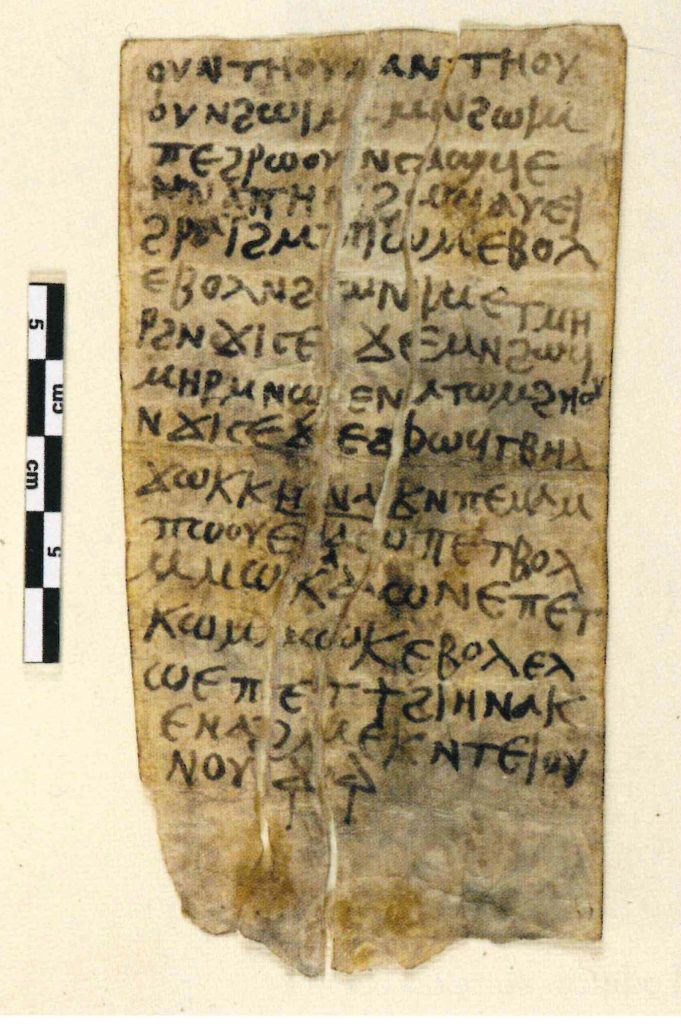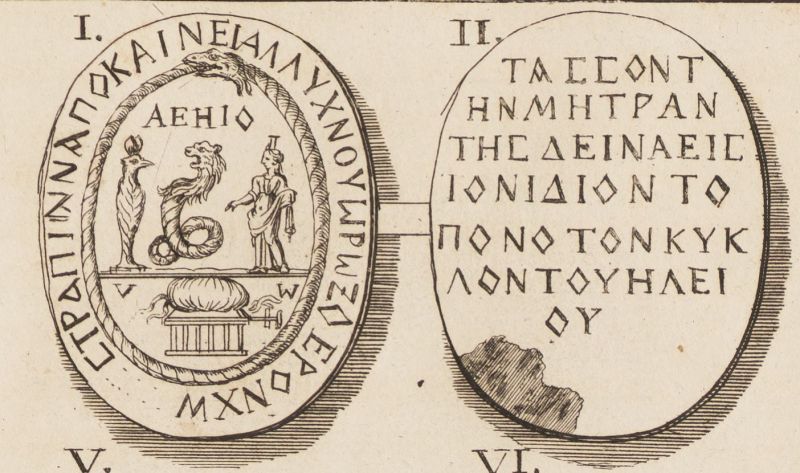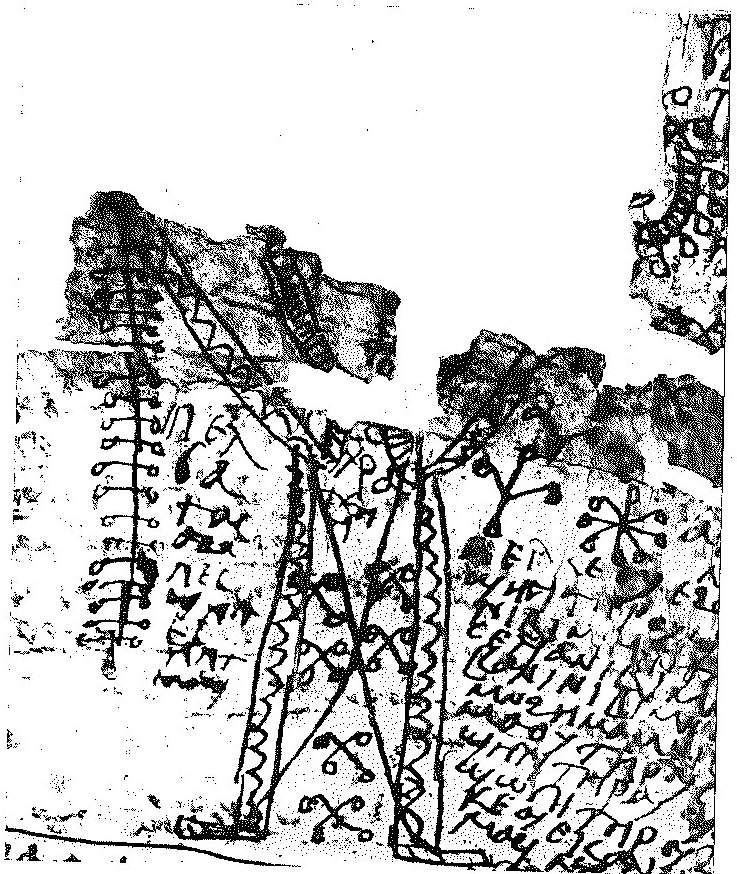
Our last post in this series established two categories of magical manuscripts – formularies, which contain magical recipes, and applied texts, created in the process of magical rituals and embodying their power. We deliberately chose a very clear example to illustrate this division, but in many cases the line between the two is not so obvious. This week we’ll look at a few confusing examples of magical objects which show features of both formularies and applied texts.
In most cases, these texts are ambiguous because they show features that we would consider typical of both categories of manuscript. P. mag. copt. Saqqara hypogees F17.10, a small piece of paper with a long name, is one example of this. It was excavated from a grave in Saqqara in 2003, and first published by Jacques van der Vliet last year. Probably dating to the tenth century CE, it contains a charm which begins with an evocative passage:
There is wind when there is no wind.
P. mag. copt. Saqqara hypogees F17.10 ll.1-6
There are waves when there are no waves.
The sound of seven snake heads,
They rose from the sea
in order to unbind every snake…
Although the charm is vague about its purpose, it seems to be focused on the idea of “unbinding” – van der Vliet suggested that it was intended to clear a blocked nose, but it might have had another function – freeing an individual from a binding curse, for example. It ends with the Christian God, named with three different Hebrew names, promising salvation:
It is Iao who unbinds you.
P. mag. copt. Saqqara hypogees F17.10 ll.11-16
It is Adonai who sets you free.
It is Eloe who provides you the way to be redeemed in this very hour, you, NN.
Here we see the generic name-marker, NN, which shows where the name of the individual for whom the charm was performed should be added, usually a sign of a recipe from a formulary. But, because of its small size, and the fact that it was folded many times to form a tiny package, van der Vliet suggests it was actually an applied text. There is therefore a conflict between our textual and material criteria for classification, and so we must try to understand this manuscript holistically, and think of explanations for this contradiction. If it is an applied amulet, the copyist might have left in the generic name marker either by accident, because they didn’t realise they needed to insert the actual name, or deliberately, creating a generic amulet which could be given to anyone. If it is a formulary, it might have been folded for transport or disposal, or even to be re-used as a magical text.
If we turn to other objects, we can see clearer examples of both of these possibilities. While we haven’t discussed magical gems before in detail, these artefacts are another form which applied objects might take, and they have been found in their thousands around the Graeco-Roman world. Because they were intended to be worn on a ring or a necklace, magical gems are, almost without exception, applied texts, and yet they occasionally contain some of the identifying features of formularies – titles, instructions, or the generic name marker.

CBd-2925 is a gem which would have been lost to history if it had not been copied by the collector of curiosities Claude du Molinet in 1692. It is an amulet to prevent uterine pain, which was believed to be caused by the womb wandering from its usual place. It is decorated on one side with a stylised image of a womb, protected by an ouroboros and three deities, including Isis and the lion-headed serpent Khnoubis. On the back it has a short text written in Greek:
Put the womb of NN in its proper place (in the same way) as (the sun god moves) the solar disk.
CBd-2925
Here we see a clear example of an applied text which has copied the generic name marker from its model. As Campbell Bonner, the grandfather of magical gem studies, pointed out, even if the carver didn’t want to insert the wearer’s name, it would be normal to insert a different generic phrase, “the one who wears this”, rather than retaining a bare NN.
The final example we’ll consider here is British Library Ms. Or. 5525, one of the tiny number of Coptic texts found in the Genizah of the Ben Ezra Synagogue in Cairo. Likely dating to some time shortly after the 9th century CE, it is a tall sheet of pale parchment, written in black ink. At the top is a damaged image of an angel, holding a staff and orb in his hands, and it contains a long invocation to this angel to protect a pregnant woman, her child, and every child born to her, from a long series of evil influences:
Watch and protect the four sides of the body and the soul and the spirit and the whole house of NN and her child who is in her womb, as well as every child which she bears. Give long life without any disease. Cast forth from her every evil force! Do not ever allow them to approach her, or any of her children who she bears. Cast forth from her every doom and every numen and every Apalaf and every Aberselia and every power of darkness and every evil eye and every eye-shutter and every chill and every fever and every shivering! Master them all! Cast them away from her and away from all her children that she bears, and away from all her dwellings, quickly, quickly! Do not allow them to approach within two hundred miles of her, ever, or of the child with whom she is pregnant!
British Library Ms. Or. 5525 ll.11-30

As we can see, this text contains the generic name marker, and this, as well as its large size – 37 cm high by 23 cm wide, larger than an A4 sheet of paper – suggest that it may originally have been a formulary. Yet it has has been transformed into an amulet by another writer, or perhaps the same writer using a different pen at a later date. This editor has added the name of a woman – Soura daughter of Pelca – throughout the text. Her name is written at the end of each section, and even inside the body of the angel. This apparently wasn’t enough for this writer, since he proceeded to recopy this section onto the back, replacing NN with Soura’s name. The text was then folded numerous times, just as smaller amulets would be folded, to form a small, portable package.
The categories of formularies and applied texts are useful for understanding the processes of ancient magic, and for making sense of the manuscripts which attest to it. But the three examples chosen here show some of the ways in which the seemingly fixed boundaries between the two categories can be crossed. In some cases, manuscripts may simply be too ambiguous to be easily classified. In other cases, inexperienced or uncareful copyists might accidentally reproduce parts of formularies onto amulets that they were meant to omit. In a few rarer examples, as in the amulet to protect Soura, we even find magical recipes being appropriated, and transformed directly into magical objects.
References and Further Reading
The Campbell Bonner Magical Gems Database
A fantastic website cataloguing information about and images of hundreds of magical gems. The example discussed here is no. 2925 in the database.
Bonner, Campbell. Studies in Magical Amulets: Chiefly Graeco-Egyptian. University of Michigan Press, 1950. URL
The classical work on magical gems. Bonner describes an example of a gem into which the generic name marker has been miscopied on p.50.
Faraone, Christopher A. “Scribal Mistakes, Handbook Abbreviations and Other Peculiarities on Some Ancient Greek Amulets”. MHNH 12 (2012): 63-74. URL
An article discussing other examples of magical gems which show features probably copied by mistake from handbooks.
Jordan, David. “Notes on Two Michigan Magical Papyri”. Zeitschrift für Papyrologie und Epigraphik 136 (2001): 183-193.
An article discussing examples of Greek texts which blur the line between formulary and applied texts.
Kropp, Angelicus. Ausgewählte koptische Zaubertexte. Übersetzungen und Anmerkungen. Vol. 1, Bruxelles: Édition de la Fondation Égyptologique Reine Élisabeth, 1931, no. C, pp. 15-21.
The Coptic text of British Library Ms Or. 5525 is published in this volume as text no. C.
Meyer, Marvin W., and Richard Smith. Ancient Christian Magic: Coptic Texts of Ritual Power. Princeton (New Jersey): Princeton University Press, 1999, no. 64, pp. 120-124.
A translation of British Library Ms Or. 5525 is published in this volume as text no. 64.
van der Vliet, Jacques. “Charming a Clogged Nose: A Late Coptic Magical Spell from Saqqara.” Journal of Ancient Near Eastern Religions 18 (2018) 145-166. URL
Article containing text, translation and discussion of P. mag. copt. Saqqara hypogees F17.10.
